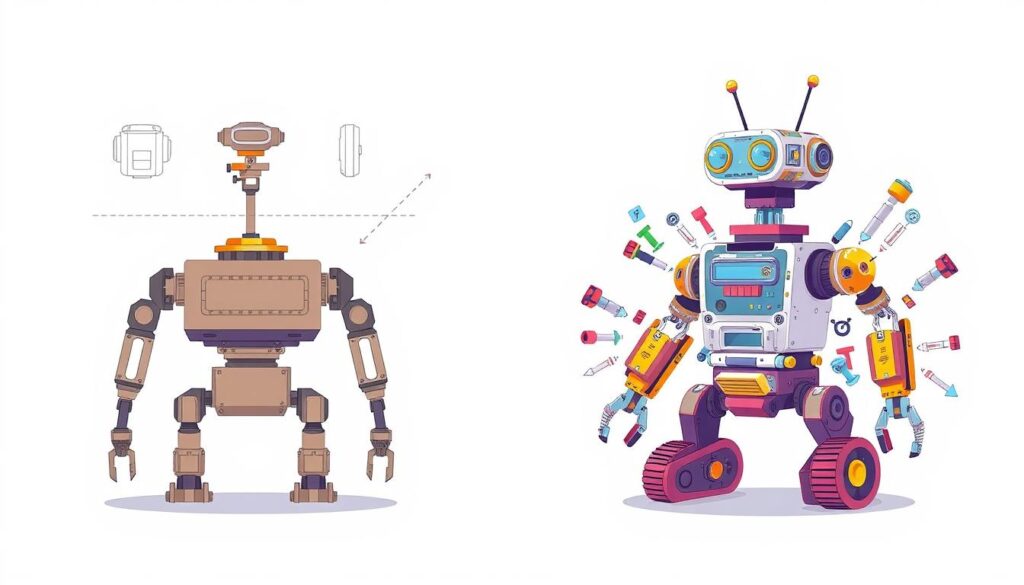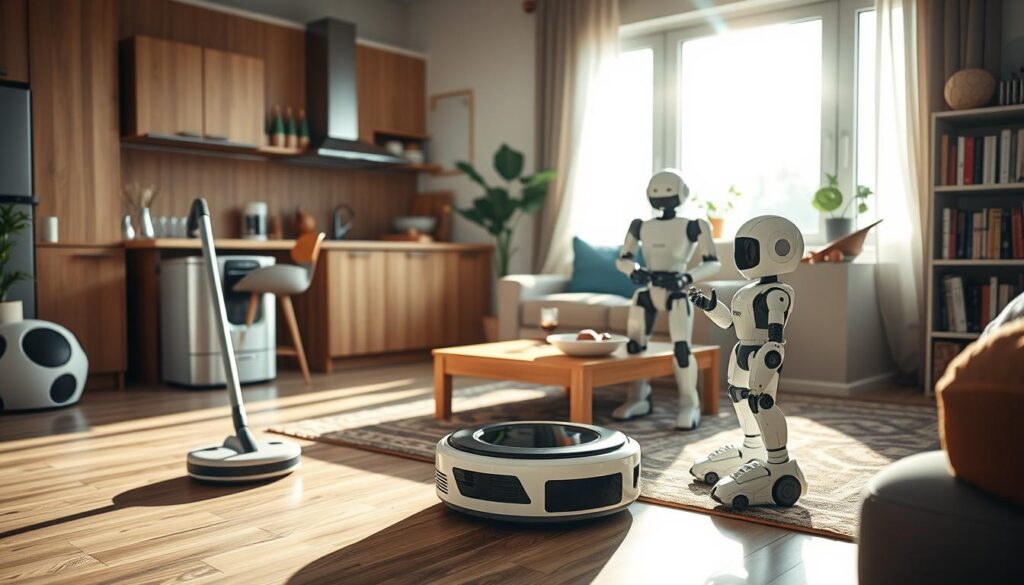The field of home robot engineering is growing fast. It needs a deep understanding of different design methods. These methods are key to making home robots work well and easy to use.
Creating home robots is a complex task. It involves many areas like autonomous systems and machine learning. Engineers must think about both the technical side and how the robot fits into the home.
Design methods for home robots often use frameworks like the Verein Deutscher Ingenieure (VDI) 2221 process. These methods mix top-down and bottom-up designs. This helps designers meet home robot needs while staying flexible.
Home Robot Development: An Overview
The robotics world is moving fast, and home robots are a big part of it. These smart machines are made to fit right into our homes. They help with many tasks and make our lives better.
Understanding the Challenges
Creating home robots is tough. They need to work well, be safe, and easy to use. They must also get along with people in our homes. Making them work in different places and situations is a big goal for engineers and designers.
Importance of Design Methodologies
Choosing the right design methods is key for home robots. Using the latest in robotics engineering, autonomous systems, and human-robot interaction helps make robots that are smart and easy to use. This makes people more likely to accept and use these robots in their homes.
Today’s home robots use cool tech like sensors, cameras, and AI algorithms. They help with security, health care, and even being friends. This shows how much we need these smart helpers in our homes.
Top-Down and Bottom-Up Design Processes
In the world of robotics engineering and autonomous systems, two main design methods are used: top-down and bottom-up. Each has its own benefits and challenges when making home robots.
The top-down design starts with a big picture of the system. It defines the overall function and needs first. This method is great for complex systems that need a unified design. It breaks down the system into smaller parts, making sure it works as planned.
The bottom-up design starts with making individual parts or behaviors. These parts then come together to form a bigger system. This method is popular in behavior-based robotics. It makes the system flexible and can handle changes or errors well.
| Top-Down Design | Bottom-Up Design |
|---|---|
| Starts with high-level system architecture | Begins with individual components or behaviors |
| Focuses on breaking down the system into smaller subsystems | Allows for greater flexibility and adaptability |
| Ensures the final product meets intended objectives | Enables complex behaviors to emerge from simpler interactions |
Both top-down and bottom-up designs are valuable in robotics engineering for home robots. Knowing their strengths and weaknesses helps designers mix them. This way, they can make home robots that are both innovative and practical.

The Proposed Hybrid Design Approach
In robotics engineering and autonomous systems, a new hybrid design is gaining attention. It blends top-down and bottom-up design strengths. This mix creates a solid framework for home robot design and development.
The Problem Definition Loop
The problem definition loop is the first part of this hybrid design. It starts with a clear problem statement. It breaks down the problem into smaller parts and sets technical needs for the robot.
Through research and a trade study, this loop lays a strong foundation. It ensures the design process is well-structured.
The Modeling and Analysis Loop
The modeling and analysis loop is the second part. It focuses on detailed modeling and analysis of the robot’s parts and systems. This bottom-up approach prepares the design for manufacturing and testing.
It makes sure the design meets technical requirements through thorough testing and simulation.
The Validation and Verification Loop
The validation and verification loop is the final step. It involves testing and manufacturing the robot. This loop allows for adjustments and improvements to the design.
It checks if the robot meets the technical requirements and works as expected. This ensures the final product meets its goals.
This hybrid design approach combines three loops for a comprehensive framework. It uses the best of both top-down and bottom-up methods. This makes the robotics engineering and autonomous systems in home robots better in quality, efficiency, and reliability.
Role-Character Design Process for Home Robots
The home robot industry is growing fast. The design process for these smart machines is getting more complex. A key part of this is role-character design. It focuses on making the robot’s personality and how it interacts with people to build strong emotional bonds.
Establishing Robot Characteristics
Designing home robots that are fun to interact with is very important. Things like how the robot looks, sounds, and acts all shape its personality. Designers need to think carefully about these details to make a robot that is both useful and friendly.
The Aeolus R1 robot, shown at CES 2018, had a sleek design and looked a bit like a person. It aimed to be both useful and welcoming. The goal is to make robots as good as Rosie the Robot Maid from fiction. This means combining hardware, software, and how people interact with robots for a great experience.
Scenario-Based Design Methodology
Another important method is scenario-based design. It involves testing different situations and how the robot will act in them. This helps designers make sure the robot behaves well, focus on the right features, and give users a good experience.
As robots become more common, they will change our society and culture. More designers want to work on home robots because they blend technology, software, and interaction with people. By using role-character design and scenario-based methods, developers can make robots that are smart, friendly, and fit well into our daily lives.

Concurrent Engineering for Home Robot Design
Designing home robots needs a team effort. Design and engineering teams must work together. This approach, called concurrent engineering, is key. It makes sure the robots look good and work well.
Integrating Design and Engineering Teams
In home robot design, design and engineering teams must join forces. They work together from the start. This way, they can mix the robot’s looks, feel, and tech skills.
The design team focuses on the robot’s looks and how it feels to use. The engineering team works on the robot’s tech side. Together, they make sure the robot looks great and works right.
- Enhance overall robot performance and versatility
- Identify and resolve design-engineering conflicts early in the process
- Optimize the balance between form and function
- Streamline the development timeline and reduce costs
Using concurrent engineering helps designers and engineers. They make robots that are both beautiful and functional. This leads to a better experience for users.
Conclusion
The growth of home robots has brought new design challenges. These challenges need a complete and connected approach. By knowing the differences between top-down and bottom-up design, and a new hybrid method, teams can make robots that meet our needs at home.
This article showed how important it is to match robot features with what users want. It also showed how combining design and engineering is key. As more people want smart home tech, these design ways will help shape the future of home robots.
Robotic vacuum cleaners like Roomba and open-source systems like Dobb-E show the industry’s bright future. By using these design ideas and listening to what people want, robotics can make robots that fit into our lives better. This will make our homes more productive, comfortable, and enjoyable.

